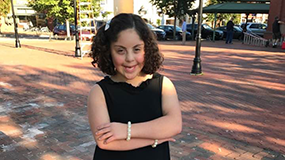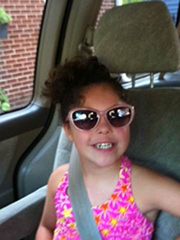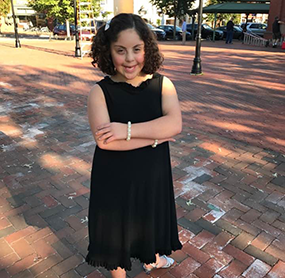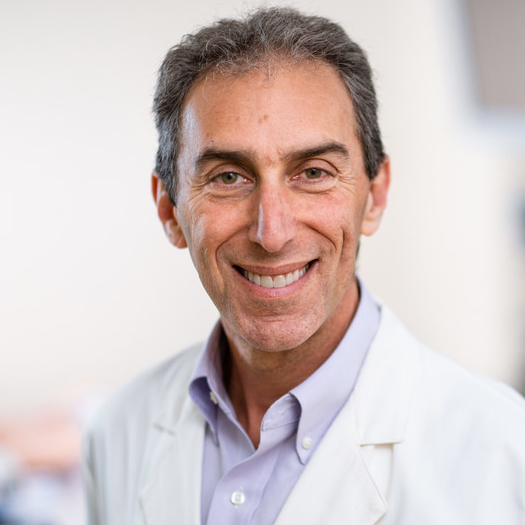
Sophia's Story

 During a routine 20-week prenatal ultrasound, Carol Kando-Pineda’s obstetrician in Fredericksburg, Virginia, spotted abnormalities in Carol’s unborn child that she referred to as “possibly inconsistent with life.”
During a routine 20-week prenatal ultrasound, Carol Kando-Pineda’s obstetrician in Fredericksburg, Virginia, spotted abnormalities in Carol’s unborn child that she referred to as “possibly inconsistent with life.”
“It was terrifying,” says Carol, thinking back on the experience. “We were sick with worry, anxious, fearful and very pessimistic about the chances for Sophia’s survival.”
The obstetrician scheduled an appointment with pediatric cardiologist Mary Donofrio, MD, who then worked for a hospital in Virginia and is now the director of the Fetal Heart Program within the Children’s National Heart Institute, to take a closer look.
Sophia was diagnosed with tetralogy of Fallot, an AV canal defect and a small left ventricle, or lower left chamber of the heart. This combination of defects means she had a hole between the heart’s upper chambers (atrial septal defect); a large hole between the heart’s lower chambers (ventricular septal defect); a single, common valve allowing blood to flow into both ventricles (normally there is one for each side); and stenosis of the pulmonary valve, which restricted blood flow to her lungs. In addition, the single valve allowing blood into her heart’s ventricles was directed more towards the right side. This made her left ventricle – which normally pumps out blood to the body – much smaller than normal and made it difficult for a complete repair to create a normal, two-ventricle heart.
The family and Dr. Donofrio discussed that Sophia would likely need a multi-step operation called the Fontan to reconfigure the way blood circulates through her heart, lungs and out to the body. It was a devastating triple-threat, but for the first time since hearing that something was potentially wrong with their child, the family also found hope.
“Meeting with Dr. Donofrio was a really critical point for us. We had gone into the appointment thinking our baby might live for only a few days after birth, and hoping, maybe, we’d get 6 months or a year with her,” says Andre Pineda, Sophia’s dad. “She didn’t sugarcoat it for us, but she gave us a plan and told us how to advocate for Sophia as we started navigating complicated medical situations. She also gave us the hope that we might be able to save her and give her a childhood. That was life changing.”
 When Sophia was born a few months later, doctors also diagnosed her with Down syndrome, but overall, she was healthier than expected. At 5 months old, she had her first surgery called the Glenn operation, which connected the large vein that carries deoxygenated blood into the heart from the upper body (superior vena cava) to the pulmonary artery as a first step to the Fontan operation, at a hospital in Philadelphia.
When Sophia was born a few months later, doctors also diagnosed her with Down syndrome, but overall, she was healthier than expected. At 5 months old, she had her first surgery called the Glenn operation, which connected the large vein that carries deoxygenated blood into the heart from the upper body (superior vena cava) to the pulmonary artery as a first step to the Fontan operation, at a hospital in Philadelphia.
When Dr. Donofrio joined Children’s National in September 2004, the family followed her to Washington, D.C. At 18 months old, Sophia had a second open heart surgery performed by Richard Jonas, MD, division chief of Cardiac Surgery and co-director of the Children's National Heart Institute. The Fontan operation connected the large vein that carries deoxygenated blood into the heart from the lower body (inferior vena cava) to the pulmonary artery through a tunnel running inside the heart. Her right ventricle, with a path to the aorta through the hole between her heart’s lower chambers, was then more easily able to pump oxygenated blood to the body.
“Dr. Jonas displayed tremendous skill and experience working through her complex problems, but another aspect of his care also was truly impressive,” Carol remembers. “He personally visited her hospital bed every day for two weeks during her recovery. Despite having had many operations, we’d never experienced that level of personal attention by a surgeon after a procedure.”
Sophia continued to have many procedures throughout the next few years, but 2016 proved to be pivotal for her health and her future.
During a sleep study, doctors at Children’s National noticed that her heart was beating much more slowly than it should be, and for a brief period, it stopped. The care team had been monitoring her heart for years, knowing that one day she would need a pacemaker, and that time had come.
“Sophia’s had many surgeries at Children’s over the years, but this was the first cardiac surgery since she was an infant,” says Carol. “We were all more anxious than usual, but Charles Berul, MD, and the Children’s electrophysiology team took great care of her.”
It was about the same time that Sophia’s interest in painting took off.
“She’s always liked art and drawing, but about a year ago, her skill and attention to painting with Chinese watercolors grew dramatically,” says Carol. “Sophia sometimes has difficulty expressing herself verbally, but her art allows her to share thoughts and feelings openly and clearly. It’s become a channel through which she can interact with the world.”
Now, just 14 years old, Sophia just launched www.Sophiola.com, a business to sell notecards, prints and other products featuring her art and sharing her beautiful vision of the world.
“We knew about Down syndrome before having Sophia, but we had no direct interaction with the condition previously. It’s sometimes a difficult road, but it can be a blessing in a way you can’t even realize,” says Andre. “Everyone has something to contribute, and we hope someday that her business will be able to employ other people with intellectual disabilities.”
Dr. Donofrio shares her excitement for Sophia and her family saying, “It’s been incredible to watch Sophia grow into a beautiful and talented young lady. Sophia’s parents are an inspiration, and I feel privileged to know them. Their love, strength and belief that their daughter could not only live, but also thrive and be happy and successful is what has led to this amazing success story. I will definitely be first in line to buy one of her paintings. I am hoping I can convince her to paint a vibrant and colorful heart for me; one that reminds me of her and of all the very special kids I care for at Children’s.”





